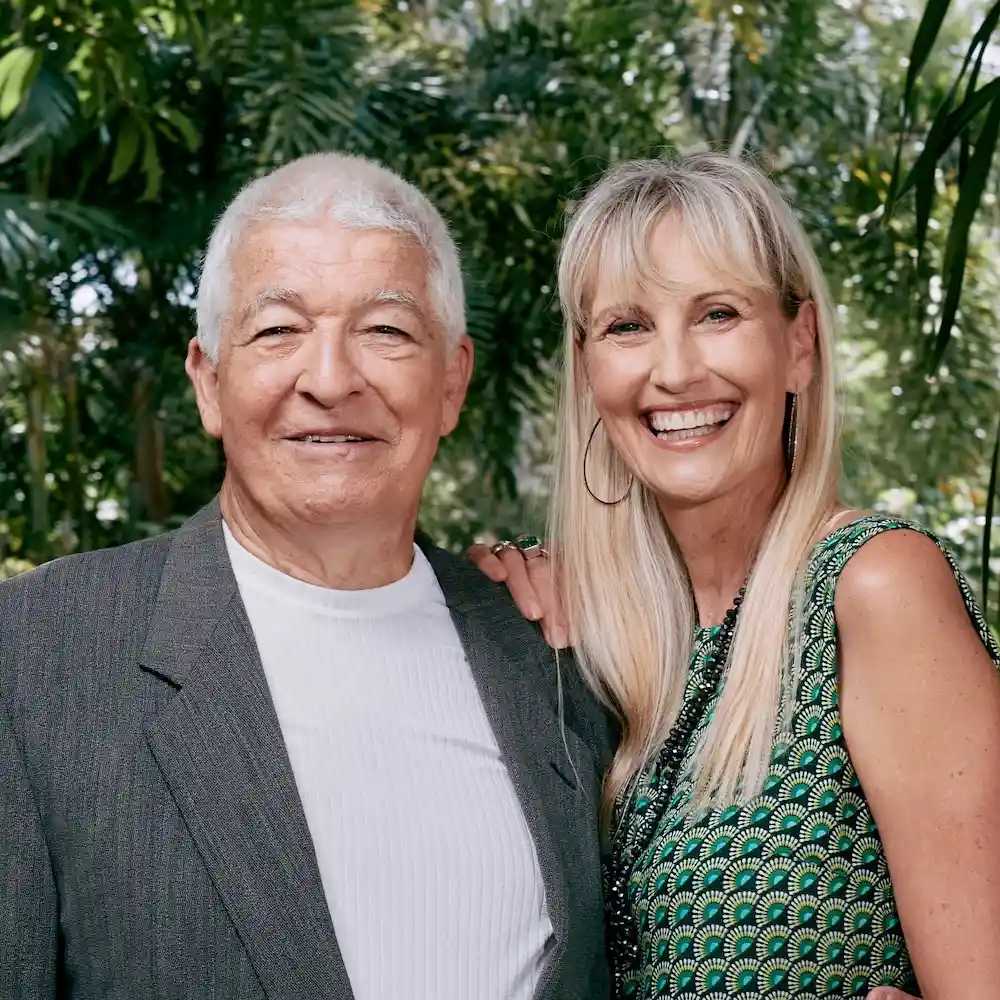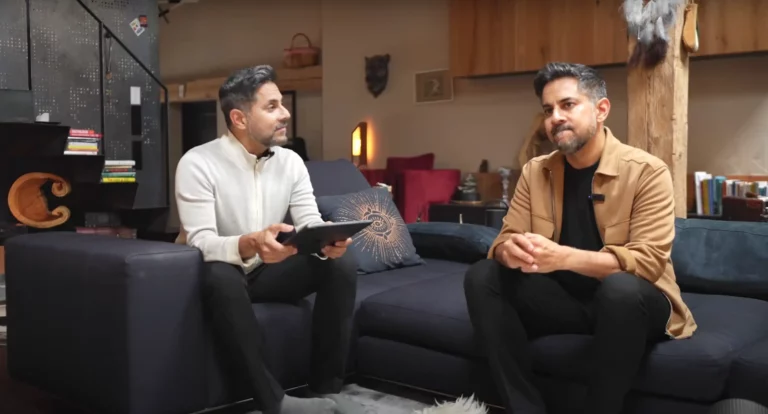“Stop copying me”—that’s the common flustered response to that silly game when we were kids. Little did we know how mirroring body language is key to building stronger, more meaningful relationships.
It’s a technique we all use, whether we realize it or not. And according to Allan and Barbara Pease, trainers of Mindvalley’s Mastering Body Language: Truth, Love, Lies & Power Quest, it’s the secret to connecting with people.
Imitation is the sincerest form of flattery, so they say. In the instance of body language mirroring, it’s a strong indication that the other person wants to connect with you—and that is flattery at its finest.
What is mirroring?
“Monkey see, monkey do” is the essence of mirroring body language (or simply called “mirroring”). It’s a form of imitation—a subtle (and usually unconscious) miming of the other person’s body movements, facial expressions, speech, and so on.
According to Allan, “Mr. Body Language,” we do this technique for several reasons:
- To create a sense of bonding,
- A way of being accepted by the other person, and
- To build rapport.
It’s often on the list of dating tips, so one common question that gets brought up is: is mirroring body language flirting? It can be because it allows people to feel at ease and gives off the “the vibes are good” signals, according to Allan. However, it doesn’t always mean that it is.
This nonverbal yet effective communication is a natural human behavior. And mimicking another helps us be in sync with them.
What does mirroring body language mean, according to science?
Scientifically, mirroring is known as “limbic synchrony”:
- Limbic refers to structures and nerves in the brain that control certain emotions and motivation.
- Synchrony is when two or more things happen, develop, or move simultaneously.
Allan explains that this innate behavior dates back to ancient times. It was used as a means to help our ancestors fit into large groups, which, in turn, helped with survival. And in modern times, the reasons haven’t changed much.
We, ourselves, have been using mirroring since we were babies. Our heartbeats follow the same rhythm as our mothers. And as we grow, we take on the mannerisms and behaviors of our parents, friends, and community.
Why do we, as humans, do this?
It so happens that we have something in our brains called mirror neurons. Its purpose is to respond to actions that we see in the people around us in the same or similar way.
For example, if the person in front of you yawns, your brain registers this movement. Mirror neurons in your brain are then fired. And then, you, too, start yawning.
These neurons play a key role in our behavior as empaths. It provides us the capacity to experience how the other person feels, enabling us to connect with them on an emotional level.
Signs of mirroring body language
While we don’t often realize we’re mirroring someone, we also don’t often realize when we’re being mirrored. But the thing is, it happens more often than we’re aware of.
So what are the telltale signs of a person’s mirroring body language? Looking at different situations, here are some cues you can pick up on.
Examples of mirroring in dating
- Hand gestures. If you’re someone who “speaks” with your hands, then see if the other person mirrors your gestures. For example, if your hands are open with the palms showing, they do the same or something similar.
- Facial expressions. When it comes to dating or the possibility of it, here’s what facial expressions can signal in mirroring body language: flirting. There are approximately 10,000 different expressions and many of them are bound to say, “Come hither.”
- Body orientation. A person who is interested in you will position themselves to match your pose. However, they’ll turn their body away from you if they don’t fancy a connection.
Examples of mirroring in the workplace
- Tonality. Your emotions are often expressed in your voice. When you’re excited, happy, or motivated, your intonation usually goes up. It’s quippy and bouncy. And if you notice that their tone of voice is the same, that’s an indication of mirroring.
- Eye contact. This can be a difficult one for those who consider themselves socially awkward. However, in many world cultures, it’s one of the most revealing mirroring body language techniques. And according to a 2016 study, the average length of time to make eye contact before it starts to get uncomfortable is 3.3 seconds.
- Head orientation. Head tilt signals interest and is the most commonly picked-up cue for mirroring body language. However, there are others: head up (authoritative, self-confident, and even arrogant) and head down (feeling intimidated, threatened, or disapproved).
To decipher whether there’s a connection between you and another person, you can consciously notice if they are mimicking your movements. Learning the ways of mirroring body language is also a surefire way to communicate that you find interesting as well.

How to use body language mirroring: 3 simple tips from Allan & Barbara Pease
Mirroring body language unconsciously is powerful in itself. However, when you know how to use it intentionally, it’s an incredibly beneficial interpersonal skill to master.
To be able to mirror is so powerful. You’ll be able to see when others naturally mirror you or not. And you’ll be able to mirror others to quickly develop rapport.
— Barbara Pease, co-trainer of Mindvalley’s Mastering Body Language: Truth, Love, Lies & Power Quest
If you want to be more aware of your body language mirroring skills, then here are three tips from Allan and Barbara in their Mindvalley Quest. It can help increase your influence and likeability.
1. Remember to “front”
Before all else, “front” yourself. It’s simply orienting your body so that you’re in front of the other person. This allows you to be present and give them your full attention.
It’s the same concept as pointing your lead foot toward the person of interest. (And if you’re dating, this is also one of the signs of attraction.)
Allan’s tip: “If you want someone to feel important when you’re talking with them, put your lead foot pointing towards them. And they’ll get a feeling you kind of like them and they don’t know why. It’s because you’re pointing your foot toward them.”
2. Use your face as feedback
Your facial expressions are great assets—they help express what you feel (good or bad). And when you’re mirroring body language for attraction, during a job interview, or basically in any interaction with another human, it can help build rapport and trust quickly and easily.
One thing to note, though, is that men and women are programmed differently to express emotions through facial expressions. According to Allan, a woman can use an average of six facial expressions in a 10-second listening while a man makes less than a third of that.
Allan’s tip: “Use your face as feedback”—for a woman, mirror her expressions, no matter how animated it is, and for a man, mirror his expressions, even if they’re passive.
3. Use the three-second rule
When mirroring body language, there are tips out there to wait up to 10 seconds or anywhere between 10 to 30 seconds before following the person’s gesture. However, according to Allan, one, two, three — that’s the simple rule of thumb to follow here.
What’s the lure of three? The brain love patterns and three is the smallest number needed to create a pattern, like a triangle. But simply, the power of three is just appealing and easier to remember.
Allan’s tip: “Make sure you wait three seconds after each gesture that they make before you copy their gesture.”
Let your body language do the talking
Building better, stronger connections contributes to your overall well-being. And you don’t have to look further than your mirroring techniques.
“Intentionally mirroring other people to create rapport is a fabulous technique,” says Allan. “The significance of mirroring is one of the important body language lessons you could learn because it’s a clear way that others indicate that they agree with you and that they like [you].”
You can learn more from Allan and Barbara in their Mastering Body Language: Truth, Love, Lies & Power Quest on Mindvalley. And when you sign up for a free account, you can sample the first few lessons to get the gist of how powerful mirroring body language can really be—not only how to use it but also how to read it.
The thing is, people may not always tell you how they feel or what they think. But they’ll always show you. And when we all do our part to create rapport with one another, we can all be the changemakers the world needs.
Welcome in.









